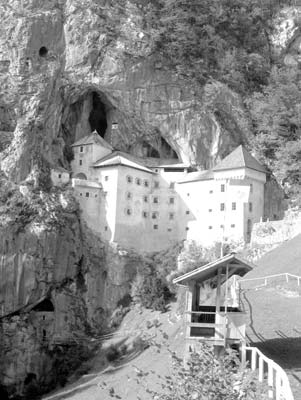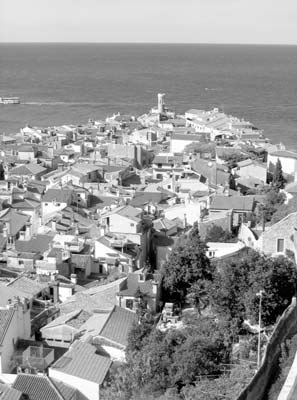For first-time travelers to Slovenia
At the conclusion of our October ’05 trip to Slovenia, my wife, Paula, and I felt that it was the most beautiful and photogenic of the 18 countries we had visited. Here are some resources and tips we would like to share from that trip.
PLANNING — Guidebooks we used included “Lonely Planet Slovenia” and “Rick Steves’ Best of Eastern Europe,” and we highly recommend both. It’s hard to beat the comprehensive Lonely Planet guidebooks for detail nor Rick Steves’ for practical guidance about European destinations.
There are also numerous Slovenian websites with a surprising amount of information in English. I found these to be useful:
www.slovenia-tourism.si — Slovenia Tourist Board. Start here, and be sure to check out the information about tourist farms.
www.dars.si — Slovenia highway information.
www.justslovenia.co.uk — similar to the Slovenia Tourist Board’s site.
www.ljubljana-tourism.si — Ljubljana tourist information.
www.bled.si — Bled tourist information.
www.piran.com — Piran tourist information.
www.park-skocjanske-jame.si — Škocjan Caves.
www.postojnska-jama.si — Postojna Caves.
www.slo-zeleznice.si — Slovenia railways.
www.slovino.si — Slovenia wine and wine tourism.
www.kollander-travel.com — Organized tours to Slovenia.
• FOOD — We loved the food. It was a mix of Italian, German, Hungarian and Balkan — surprisingly familiar and yet different with some unexpected flavors. We found it interestingly seasoned, well prepared, fresh and appealing.
Restaurant prices were low for Europe, even in Ljubljana. Lunch was traditionally the main meal of the day, so be prepared for large servings at lunch and for more reasonably sized servings at dinner.
We enjoyed several bottles of local sivi pinot wines, all of which were fine. The local beers, brand names Laško (my favorite) and Union, were quite good. Beers were typically available in third or half liters. We drank the water everywhere to no ill effect.
• CURRENCY — ATMs were not as widespread as in Western Europe. The only ATM I used in Slovenia included English as a language choice. We needed a goodly amount of cash because many attractions and restaurants didn’t take credit cards. (In January 2007, Slovenia converted from tolars to euros.)
• LANGUAGE — Language could be a bit of a problem. Slovenian isn’t the most difficult of languages, but it’s likely to be unfamiliar. It is, however, generally easier to pronounce than it looks. If you add an “h” sound after letters with a diacritical mark (e.g., cˇ, ž), pronounce “j” like a “y” and roll your r’s, you’ll be reasonably close.
Most everyone we met under age 30 could speak unaccented English, which, fortunately, included most of the restaurant and lodging workers. English-language menus were widely available in restaurants. Museum and art gallery exhibits were often labeled with English in additional to Slovenian. English-language tours were often available.
• WHAT TO SEE — Attraction prices were reasonable, if not low, but we noticed that prices were higher than those stated in our guidebooks, indicating recent increases. As Slovenia becomes more discovered, we’ll likely see even more price increases.
We loved Ljubljana’s scenic Old Town, which looked like a blend of Budapest and Bratislava. It deserves a couple of days, and you may be tempted to stay longer just to enjoy the ambience. Strolling along the river at night with the locals while listening to the music from street musicians and enjoying the aroma of roasting chestnuts was a highlight.
Be sure to go to Ljubljana Castle (great views of the city with the Alps in the background), the Cathedral of Saint Nicholas (one of the most underrated sights in the city), the Jože Plecˇnik House (time your visit for an English-language tour), the Riverside Market and the Modern History Museum.
Our pictures of eye-catching Predjama Castle (which we did not enter) in the karst district garnered the most comments of any of our set of Slovenia photos. We toured the nearby Škocjan Caves instead of the more-often-toured and touristy Postojna Caves (which are just a few kilometers from Predjama Castle). Our reasoning was that it was best to get the more physically challenging tour done while we were still capable of it, but while we walked almost 500 steps during our visit, it was not all that challenging, even for a 51-year-old with bad knees.
Piran is a gem on the beautifully blue Adriatic. A number of the city’s buildings date from the 15th century; walking through the town is like a trip back in time. At the very least, walk up to the Cathedral of St. George for a great view of the city, especially from the top of the bell tower. There are several, sometimes hard-to-find, churches in the town that are worth visiting.
There’s a gate at the entrance to the town, and you had to pay to drive into the town — and good luck parking there. We parked in a municipal parking lot just outside the gate for a small charge. There was a crowded shuttle from the parking lot into town, but we enjoyed the walk instead.
Bled and the surrounding areas are gorgeous and offer an array of sites and activities. We spent two days there and wished we had at least one more. You should definitely visit Bled Castle, take a boat out to the chapel on Bled Island, walk around the lake (and go inside Vila Bled and the Parish Church of St. Martin), walk through the Vintgar Gorge (my personal favorite of the trip) and visit the Old Town nearby village of Radovljica.
Finally, driving the 50 switchbacks and the steep grades over the Vršicˇ Pass in the Triglav National Park wasn’t nearly as hair-raising or challenging as I had feared. We had no problems and even I, the driver, was able to enjoy the breathtaking views of the Julian Alps along the route.
There are a number of sights and attractions along the popular route over the Vršicˇ Pass and down the Socˇa Valley. We just didn’t have time to see many of them. Seeing all of them on a day trip would be almost impossible without really pushing yourself. Maybe it would work if you spent a night somewhere in the Socˇa Valley, but we didn’t see many appealing lodging and dining options.
Be sure to visit the award-winning Kobarid Museum while you’re in the Socˇa Valley.
STEPHEN O. ADDISON, Jr.
Charlotte, NC



